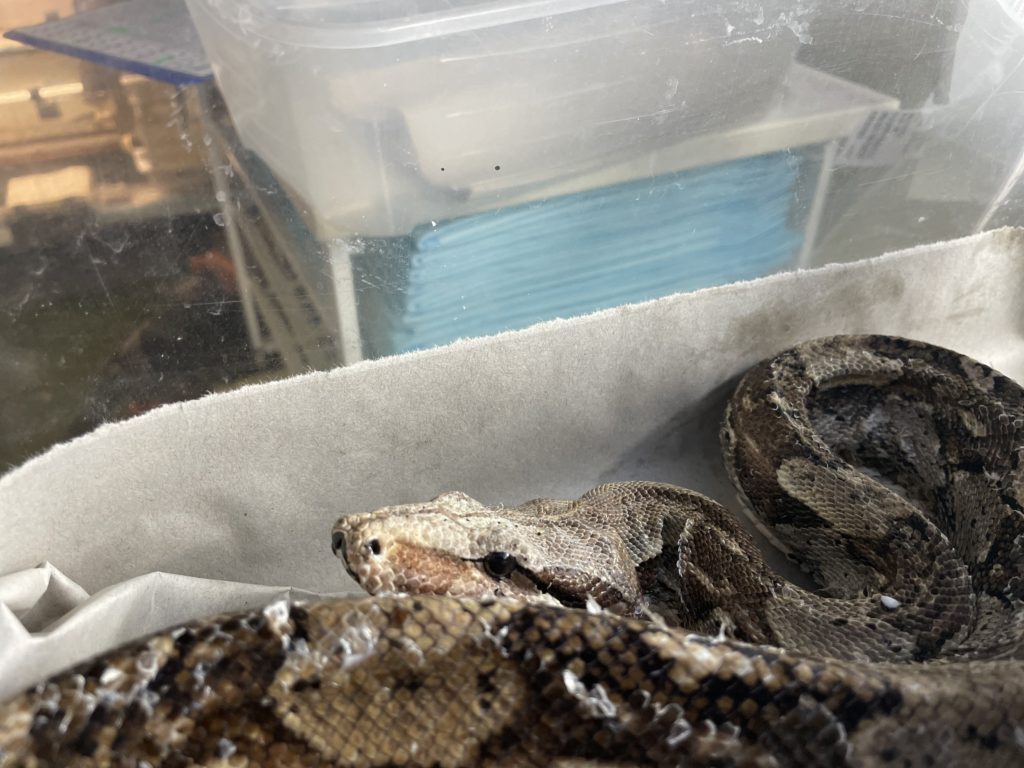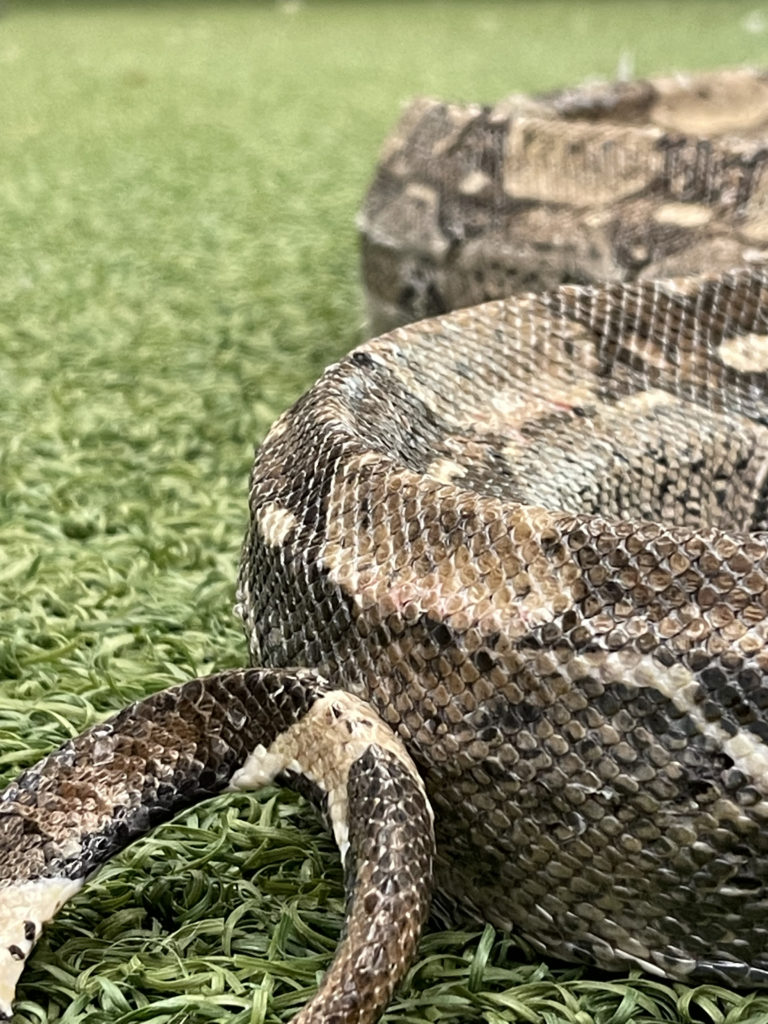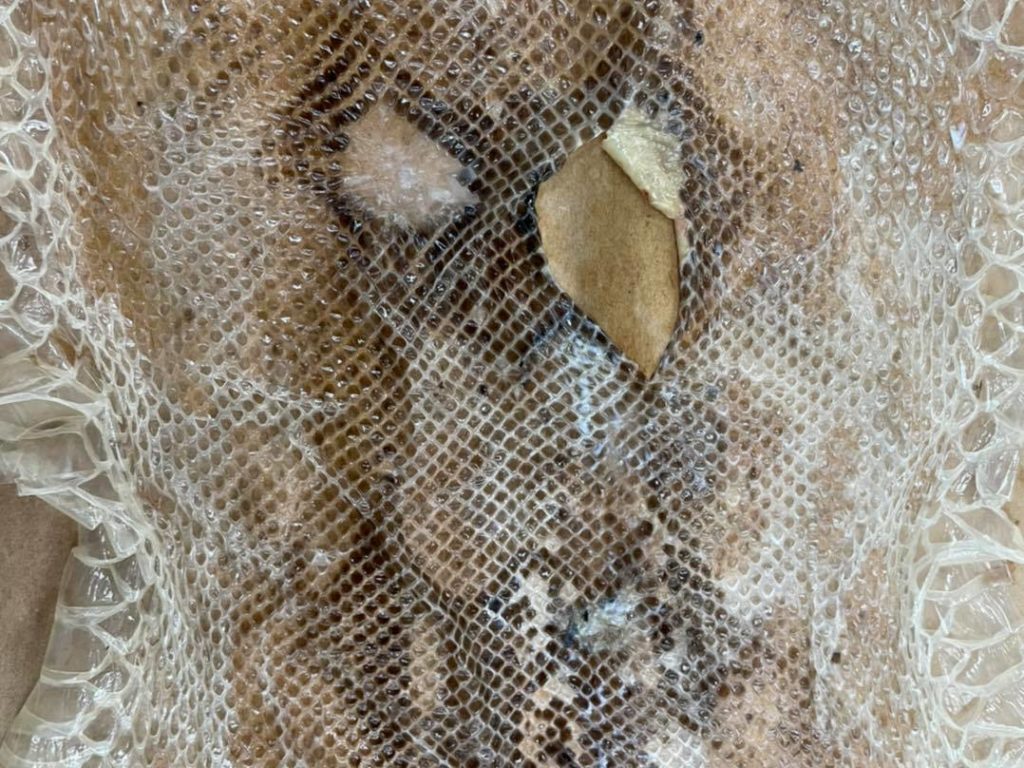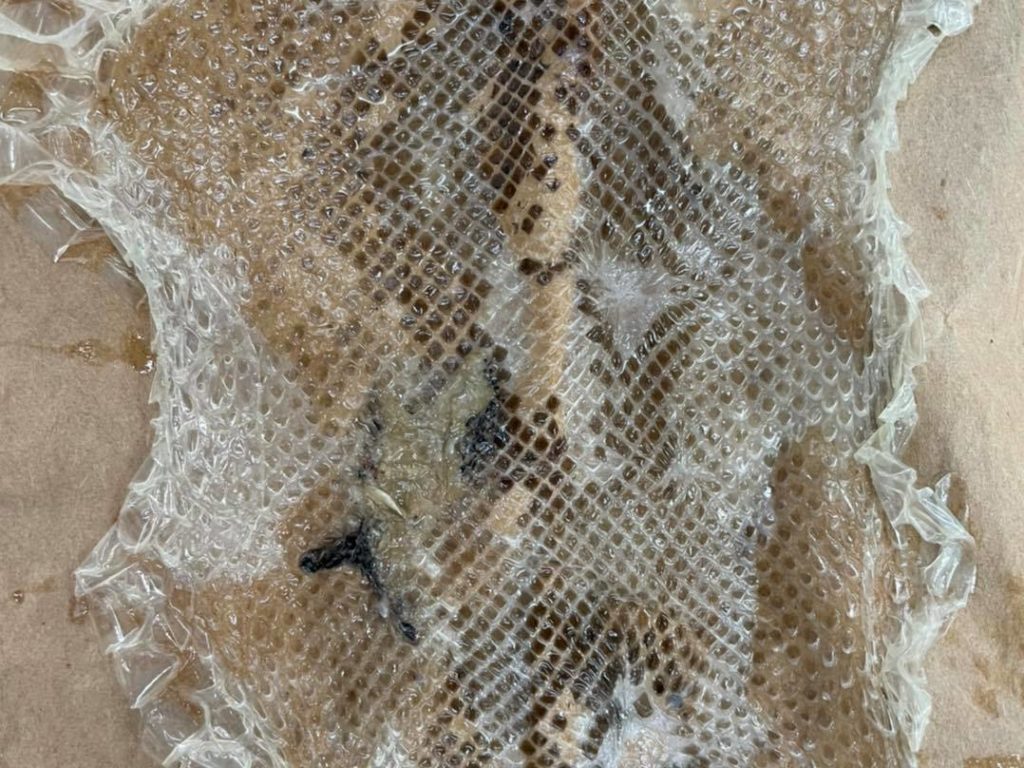This patient came to us as an emergency due to injury, however after our initial conversations with the owner it came to light this was much worse than an injury case. The owner admitted he had been dealing with some serious life changes that meant he couldn’t pay much attention to the snake or his enclosure for quite some time. In his words he “hadn’t been the best pet parent”. The owner clearly regretted his mistakes and contacted us immediately after realizing how sick his snake was.
We always change an animal’s name on arrival at Snake Haus to give them a new start. We chose the name “Grimm” in acknowledgment of his desperate fight for survival and the difficulties we knew were ahead.

VIEWER DISCRETION ADVISED:
Not intended for immature audiences! This case report includes graphic images of severe illness and wounds. Proceed with caution.
SEPSIS:
Grimm arrived in the worst condition of any rescue we have seen yet. He was emaciated and had grievous wounds. Treating a patient this debilitated requires taking it a bit slow. Reptiles have the ability to slow down their metabolism and survive for a long time with severe illness. If you warm them and hydrate them too quickly when in such a debilitated state, they can become septic. When an animal is septic warming them and hydrating them can result in mobilization of toxins throughout the body that cause tissue damage and cardiovascular collapse. The end result is often rapid and fatal.
Click the button to see pictures of Grimm on his first day at Snake Haus. These photos show the severe wounds that he arrived with:
REFEEDING SYNDROME:
Despite how emaciated Grimm was, feeding him was NOT the first thing to do. Grimm had a body condition score 1/9 which borders on the edge of incompatibility with life. At this severe stage of starvation, the patient can develop refeeding syndrome which will be fatal. Refeeding syndrome essentially happens when the patient’s body is too weak to process food. Electrolyte shifts in the body initiate a cascade of cellular death that causes the body to shut down before it can utilize the energy and nutrients being offered. Figuring out when and how to offer food is a tricky problem in cases like this. A patient with body condition score 1/9 will typically be started on hydration treatments and a liquid diet initially. Grimm’s owner had just fed him a rat when he realized how sick he was. Going into the enclosure to offer food was what resulted in Grimm coming out of his hide so the owner could see the poor condition he was in. Grimm regurgitated this meal soon after his arrival at Snake Haus. While that sounds terrible it likely saved his life. Grimm’s body was not ready to process food and by regurgitating it he prevented himself from going into refeeding syndrome.
BEHAVIORAL CHALLENGES:
Grimm’s behavior was outright fractious on arrival which is quite rare for a snake. Most snakes when scared will prefer to hide and only become defensive if they are not allowed to hide somewhere they feel safe. Unfortunately for Grimm he was unable to hide from the cause of his fear. That cause was pain. It took us a few days to understand why his behavior was so severe. The first thing we do with an animal this sick is place them immediately into an ICU cage to start regulating their temperature and hydration in a tightly controlled environment. That means a thorough exam has to wait a few days. Handling an animal this debilitated can push them over the edge. Once Grimm’s core temperature was back up into a normal range, we attempted our initial exam. He responded with profound aggression and fear. This behavior was shocking and very difficult to manage. In the process of handling him for that first exam we quickly discovered the next problem and the source of his severe behavior.
DERMAL NECROSIS:
A normal patient exam requires some mild restraint. A defensive patient often requires a bit more restraint than normal. If the animal is either trying to flee or trying to bite us, we have to hold them still in order to complete our tasks. Dr. Mayes and our LVT Kami were horrified to see that even mild restraint caused Grimm’s skin to tear! Both adjusted their technique quickly as they tried desperately to control him and keep him from hurting himself further. They were each bitten several times that day because they chose to simply allow the bites to happen rather than cause him more damage. We succeeded in getting Grimm weighed that day, administered intracelomic fluids and gave injections of antibiotic and pain medications.
Discovering how fragile his body was and seeing his heart-breaking behavior that day made us seriously consider euthanasia. His vehement fight to protect himself is what stayed our hand. We decided that as long as he showed us the desire to fight for survival, we would do our best to help him in that fight.
Now the really difficult tasks began. How do you treat a defensive snake for severe wounds if you can’t touch him? We had the answer already from our work with Toad the yellow anaconda who we treated for severe bite wounds the year prior.
Click the following button to see pictures of the wounds that occurred where Grimm’s skin tore so easily in those first days: viewer discretion advised
WOUND CARE AND HEALING:
Thus began a journey that ultimately lasted more than a year. A 4 week round of injectable antibiotics, pain control, and fluid therapy were completed and once he was strong enough tube feedings began and worked up to higher levels of nutrition. Injectable Vitamin C was also administered as there have been reports of a scurvy like syndrome in emaciated snakes. While these treatments resulted in short term healing they did not translate to long term health.
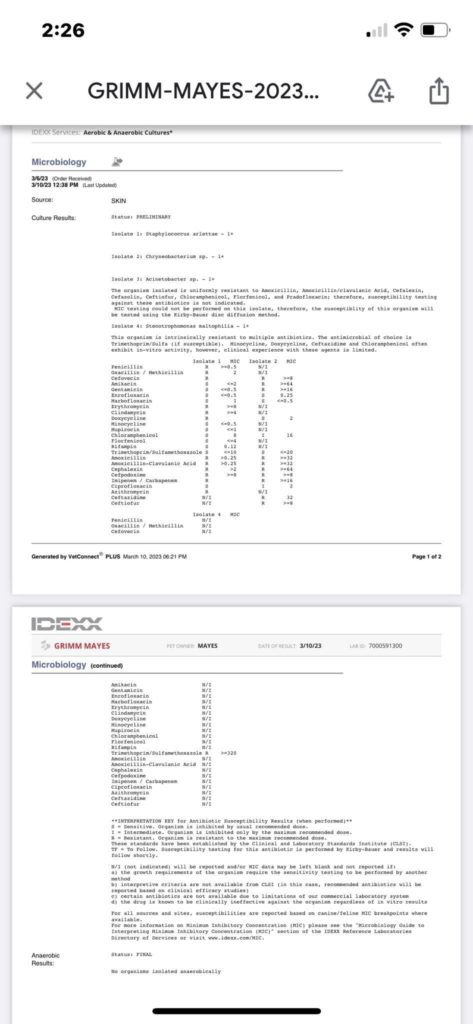
Treating a patient for severe wounds that is so fragile you can’t handle him is not easy. Thankfully we had already developed a system of treatment that could work well in this case. We set Grimm up in the Snake Haus ICU and created one of our heated medicated water baths for him. The heated water allows the body to achieve a high core body temperature which rapidly accelerates the growth of new tissue. You can read about another case in which this technique was used here: Toad’s Live Food Injuries (link coming soon).
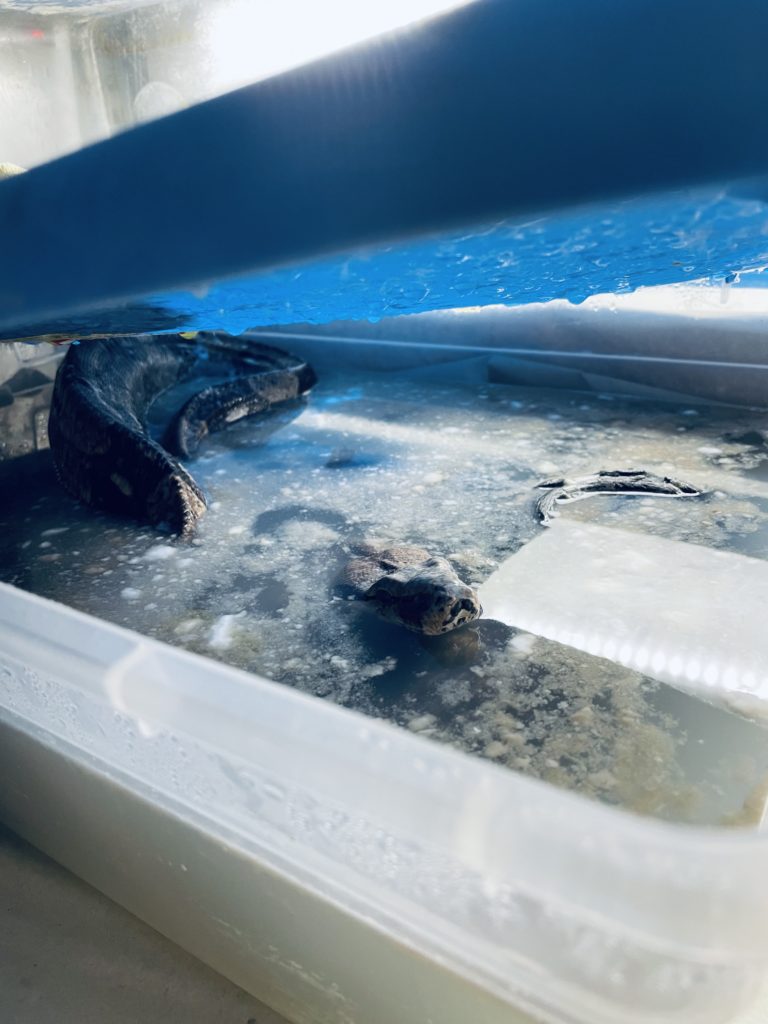
The picture above shows Grimm happily soaking in his heated bath. The debris floating in the water is his wound cream that comes off as he soaks. This cream is a strong anti-microbial and helps prevent growth of bacteria in the warm water. He spent many months in a bath like this and tolerated water changes every 3rd day when his medications were due. There is an access hole in the lid so Grimm could choose to get out of the water at any time. He chose to stay in his heated bath for weeks on end which tells us he knew it was helping him. The water is changed frequently in order to keep it clean and is always kept at a temperature of 90-92 degrees with a thermostat-regulated water heater.
Below you can watch a video that shows how we set up a heated water bath:
This next photo shows Grimm’s wounds heavily coated in Silvadene cream. The cream does several things – it soothes exposed nerve endings to calm down pain, it forms a layer over the wound to prevent it from drying out, and it is highly effective at inhibiting bacterial growth. We applied new Silvadene cream to his wounds as often as needed which usually ended up being about every 2-3 days.

SAFE HANDLING:
After our initial mistake of causing a wound during handling we quickly modified our handling techniques for Grimm to accommodate his special needs. While working through the initial intensive care treatments we had to develop indirect handling techniques to prevent causing further harm. We needed him to learn and to choose to cooperate with us for his treatments. Throughout all the time Grimm spent in his heated baths in ICU (many months) we worked on hook training with him. Hook training is a technique we use for communication with the animal. Grimm knew only pain and fear from his past experiences with people. Behavior driven by fear is defensive and reactive. We needed to change his state of mind and perspective on what human interaction meant. We took it very slow and taught him to pay attention to what we were doing. He quickly began to see that our actions were routine and predictable. He learned that our actions had meaning and that we were trying to communicate with him. He started paying close attention to what we were doing and understood what we were asking him to do.
TRAINING WITH APPLIED BEHAVIORL PRESSURES:
Training with applied behavioral pressures is how we helped Grimm understand what we needed him to do. The basics of this type of training is to apply a specific behavioral pressure that elicits a response from the animal. The hook is the tool we use to create the pressure and we apply it in a very specific way that is modified as needed until we see it elicit the desired response from the animal. The response we needed was for Grimm to move around his enclosure when we ask. We needed him to do that so that we can change his water and clean his environment without picking him up. Since Grimm dislikes touch, all we had to do is gently touch his cheek, nose, or neck with the hook and then stop touching him once he moves in the direction we need him to go.
This applied behavioral pressure accomplishes three goals.
1) It shows Grimm that if he responds in the desired way, he doesn’t receive an undesirable interaction. That gives him some control over the situation and makes him pay more attention to what we are asking him to do. This ultimately leads to choice-based handling.
2) Since the touch with the hook is so gentle and causes no pain, it slowly helps him learn that simple touch itself is not bad. Touch means more than just pain and becomes tolerable over time.
3) It turns the hook into a tool for specific directional communication, and that is an incredibly powerful tool.
Watch the video below to see an example this type of training with a different boa:
After just a few weeks of these interactions we can then just show Grimm the hook and he readily moves to the location we are asking. For normal snakes we use this to help them learn to use a hide for self-comfort and control over their own environment. That makes a hide their safe zone and is a place they can go if they don’t want interaction. This learned behavior makes it possible for us to move the snakes around without handling simply by asking them to enter their hide and then we pick up the hide to move them. This is much less stressful than forced handling. Unfortunately for Grimm, asking him to go into a hide was not safe because his skin would tear when he pushed against it. So instead, we taught Grimm to hide under a towel. A towel is soft enough that he can’t hurt himself pushing against it, but it can still be used to give him a feeling of safety and can be used to move him.
After using these techniques with Grimm for well over a year we can now easily ask him to move somewhere in his enclosure while we work around him, and he will sit calmly and stay still under a towel. You will see these behaviors exhibited in a video later in this article.
Grimm’s treatments are almost always administered with him hiding under a towel. With time he learned that his wound cream feels really good when applied so he calms quickly when under a towel and feels us gently apply the cream. By using a small 24g needle and gentle distraction we are able to administer injections without him really noticing them. These techniques for gentle handling were absolutely vital to Grimm’s continued survival and healing.
DEVELOPING A SAFE ENVIRONMENT:
When snakes are injured, they will often go through repeated shed cycles. Once they are ready to shed, the snakes push the old skin off by rubbing against items in their environment. We normally give the snakes a few different items and textures in their enclosures that they can use for this process. Unfortunately for Grimm the process is both healing and quite dangerous. When he sheds, he is at great risk of tearing his skin if he works too hard to get it off. That means we had to make sure his enclosure had smooth textures, no sharp corners, and was always very clean. His heated water baths also helped make his sheds less dangerous. By keeping his skin very warm and hydrated it made the shedding process much easier than normal for him. For each shed event we made sure to be there to assist him in getting the old skin off gently and carefully. He was usually able to get most of it off himself, but we often help him get clear of the shed wound debris and scab material that would come off along with the shed skin.
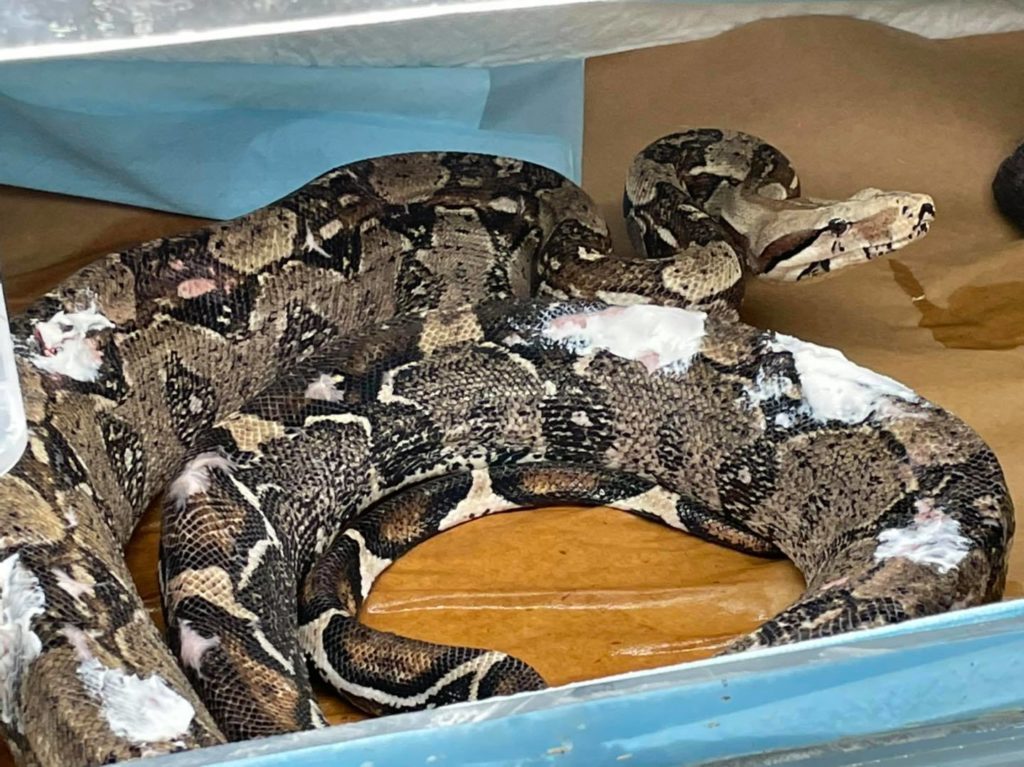
Here we see Grimm with new cream on after having just shed minutes prior.
Because a shed cycle involves growing new skin, the process aids in wound healing. This is an energetically costly process for the patient. Growing new skin over and over again requires energy and nutrients that Grimm just didn’t have. Normally we would not feed an animal during shed however Grimm desperately needed the calories. Therefore, we also initiated a feeding plan that was a bit more intense than what we would normally do. We started with very small food items and worked up from there. We fed Grimm every week as long as he seemed hungry enough to take food. The only food breaks taken were when he was deep in blue. With this set up Grimm quickly showed us that he was able to heal these wounds.
Click the following button to see photos of his wound healing in progress.
DIAGNOSING THE UNDERLYING DISEASE:
After many months of intensive care, we were able to get Grimm’s wounds all fully healed. He was eating well and slowly putting on weight. It was time to move him out of ICU and allow him to have more normal movements and routine. Unfortunately, we soon discovered that Grimm was NOT healed! Yes, his wounds were gone, and no new ones had developed but his outward appearance of health was only due to our ability to keep him safe from harm. As we began more usual training and socialization with him, he again developed new wounds. The decision was made by our veterinary team to collect surgical skin biopsies for histopathology. We had to figure out what was causing Grimm’s skin to be so fragile. We submitted a sample of the skin that he had recently sloughed during an injury as well as several punch biopsies of deeper tissue. Those biopsies were collected under sedation and local anesthesia. Due to his skin fragility the biopsy sites cannot be sutured closed like we normally would so we kept them at a small enough size that we could manage them without suture. The choice to purposely create new wounds on Grimm’s body was a difficult one but it was necessary to figure out how to further help him.
The histopathology results came back with the following diagnosis:
Necrotizing Dermatitis with fungal hyphae and bacteria
The necrotizing dermatitis was expected. That made sense. What we hadn’t been expecting was the fungal hyphae! A fungal organism colonizing his deeper skin layers may be what has caused the fragility of the tissue. Now we have a new path to take his treatment.
ANTIFUNGAL TREATMENTS:
Finding a fungal infection as the underlying cause for Grimm’s illness is both good and bad. If it’s an infection it means we should be able to treat it. It is not that simple though. There are some documented fungal diseases in reptiles, most well-known are Yellow Fungus Disease caused by Chrysosporium anamorph of Nannizziopsis vriesii, better known as CANV, and Snake Fungal Disease (SFD) caused by Ophidiomyces ophidiicola. These fungal diseases are terribly aggressive and difficult to treat. Most patients do not survive these diseases. Treatment can slow the disease down but not cure it.
Although this organism looks similar microscopically to CANV and the SFD organism, Grimm’s symptoms don’t match those other diseases. We have been contacted about two cases in other parts of the country of snakes with fragile skin that have not yet been diagnosed. One was an amazon tree boa that was euthanized due to his severe wounds and the other was a young Burmese python that passed away before antifungal therapy could be initiated. The Burmese python case had similar histopathology results as Grimm. We had hoped that we might be able to learn from and help the other cases, but those patients did not survive long enough to help shed any light on this disease.
Antifungal drugs are not as common or as easy to get as antibiotics. There are only a few drugs available, and they all can have negative side effects on the body. Topical and oral antifungals are the most commonly used. Unfortunately, snakes do not absorb oral medications well and Grimm’s infection is deep in the subdermal layers of his skin making a topical unlikely to be successful. We needed injectables.
We chose Fluconazole and started his treatment on 11/6/22. Potential side effects of injectable antifungal drugs include kidney or liver damage, destructive skin disorders, and even heart attack. We felt that we had no choice but to try and treat it. We owed it to him to try.

There are no clear dosing recommendations for this treatment in snakes, so we designed his treatment plan by combining the recommendations for this in mammals with what we know of snake medicine and extrapolating from there. One of the biggest challenges here is to try and give the injections in a way that doesn’t cause further harm. The injection size is quite large and requires restraint to administer. Normal restraint causes Grimm’s skin to tear. We had come up with what we hope is a plan that will work for him by getting him the best drug exposure we can manage in the safest way.
The video below shows how we give Grimm his fluconazole injection:
We are doing this injection twice a week and applying fluconazole topically every day. We initially prevented him from soaking so he couldn’t wash the fluconazole off but have since changed that plan. After just the first 3 injections we noticed a major change in the look and feel of Grimm’s wounds. They became wetter with a much more significant amount of blood in and around the wound edges and wound bed. We also began to see some very mild swelling around them. We are hopeful these changes are a sign that his body is responding to the injection with an improved blood supply to his skin. If that is true it could be the start of true healing. Since his wounds are changing in how they heal we decided to give him the heated water bath again. The main reason a heated water bath works is because it raises his core body temperature and should therefore improve circulation and help distribute the injectable medication throughout his body better.
We will continue this antifungal treatment for 6 weeks and then give Grimm a break. This case report will be updated once we are able to report whether on not the new treatment results in success.
After completion of his antifungal treatments samples were collected again for histopathology and showed that we had succeeded in curing his fungal infection but not the underlying skin disease.


TO BE CONTINUED . . .


